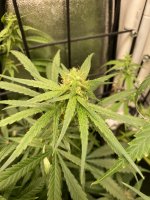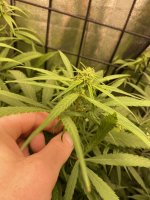North51
Active member
Hi Resinouskingping,Hi North!
I think if you go with an too small pot,you risk rootbound. I would prefer you use 11L / 3 gallon pots and much training (LST/Topping/SCROG)if you want to manage the size of the plant. Also don't veg them too long.
Veg in 1-3 L pot for about 3-4 weeks and then 11/13
After they show sex,transplant to 11L / 3 gallon.
Best Regards!
Thank you verry much for this information.
Any idea how much they stretch after flipping to 11/13. 200 to 300%
Last summer i grow a Neville's Haze (Haze dom) and after flipping to 11/13 thé stretch was +/- 300%. She was transplanted in livingsoil (earth)



 Thanks friend!
Thanks friend!
